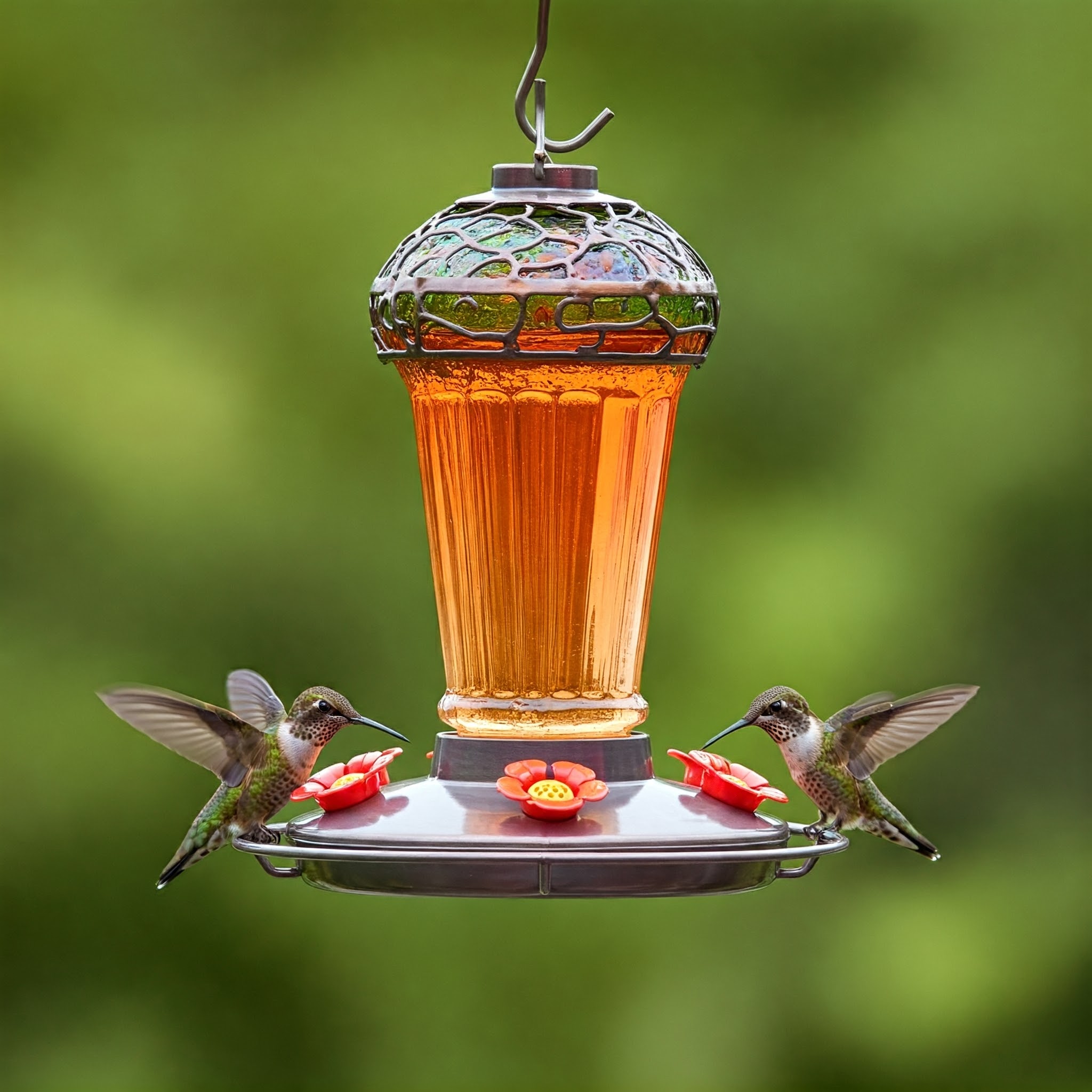Here are some answers to common questions about hand painted hummingbird feeders and wooden hummingbird feeders.
1. What specific types of wood are best for a wooden hummingbird feeder’s longevity?
Woods like cedar, cypress, and teak are popular choices for hummingbird feeders due to their natural durability, resistance to rot, and ability to handle weather fluctuations. Cedar contains natural oils that help repel insects and fungal growth, prolonging the life of your feeder. Cypress and teak are dense hardwoods that stand up well against moisture and insect damage, ensuring a long-lasting, stable platform for the feeder’s intricate hand painted designs. When properly sealed or varnished with non-toxic finishes, these woods maintain their structural integrity and keep the feeder looking attractive over many seasons.
2. How can the choice of paint type (acrylic, enamel, etc.) affect a feeder’s durability?
The quality and type of paint significantly influence both the appearance and longevity of a hand painted hummingbird feeder. High-quality acrylic paints are water-resistant and quick-drying, making them suitable for outdoor use. They often hold up well under moderate weather conditions. Enamel paints are more durable and highly resistant to chipping, fading, and peeling, offering superior long-term performance even in harsher climates. Eco-friendly paints without harmful toxins should be prioritized for the birds’ safety. Ultimately, choosing a paint that balances vibrant, long-lasting color with environmental responsibility ensures that the feeder remains both visually appealing and safe.
3. Which hand painting techniques do artisans use to achieve intricate designs?
Artisans may employ a variety of traditional brushwork methods, layering techniques, and fine detail painting to bring intricate patterns to life on the feeder’s surface. For example, some artists use underpainting to establish a base layer of color and tone before building details. Others incorporate stippling or dry-brush techniques for subtle texture and shading. Fine-tipped brushes are often used to create delicate outlines and floral motifs that attract hummingbirds. Each artisan may develop a personal signature style, blending cultural influences and natural themes, making every finished feeder a one-of-a-kind work of functional art.
4. Are certain glass shapes or thicknesses better suited for long-term hummingbird feeder use?
Yes. Thicker, high-quality glass is generally more durable and less prone to breakage than thin glass, offering better longevity. Shapes that feature a stable, balanced center of gravity—such as cylindrical or slightly rounded forms—are easier to hang securely and less likely to tip or break. Smooth surfaces simplify cleaning and prevent residual sugar from clinging to crevices. Tempered or borosilicate glass can withstand temperature changes and exposure to the elements more effectively than standard glass, ensuring that the feeder maintains its clarity, structural integrity, and artistic charm over time.
5. How can seasonal changes in weather impact the feeder’s paint quality over time?
Seasonal variations—ranging from harsh summer heat and strong UV exposure to cold, wet winters—can gradually affect paint longevity. Intense sunlight may fade colors and break down certain paint formulas. Rain and humidity can encourage mildew or peeling if the paint isn’t well-sealed or if the wood isn’t adequately treated. In regions with freezing temperatures, repeated cycles of moisture freezing and thawing can cause hairline cracks in finishes. Regular maintenance, such as periodically applying a clear, non-toxic sealant and sheltering the feeder from extreme weather, can mitigate these issues, ensuring that its colors stay vibrant and true.
6. Are there traditional cultural influences in hummingbird feeder designs around the world?
Absolutely. Artisans from different regions draw inspiration from their local cultures, ecosystems, and design traditions. In some Latin American communities—areas rich in hummingbird diversity—feeders may feature motifs of indigenous patterns, bold colors, and references to native flora. Asian artisans might incorporate delicate floral brushwork reflecting classical painting styles or traditional decorative arts. In North America, designs may borrow from folk art or local wildlife scenes. These cultural nuances celebrate regional heritage and biodiversity, providing collectors with a feeder that doesn’t just serve a practical function but also tells a story through its artistry.
7. Do hummingbirds prefer certain color palettes over others beyond red and yellow?
While hummingbirds have long been associated with a preference for red—the color they most readily recognize—studies suggest they can be drawn to a variety of bright hues like pinks, oranges, and purples. Contrasts between colors also help feeders stand out against natural backdrops. While red remains a reliable choice, experimenting with warm, saturated tones and color combinations can attract hummingbirds’ curiosity. Ultimately, maintaining clean, fresh nectar and placing the feeder in a suitable location matters more to hummingbirds than color alone, but varied palettes can make your feeder more visually appealing to both birds and observers.
8. How can you ensure the sustainability of materials used in a hand painted hummingbird feeder?
Sustainability begins with sourcing responsibly harvested wood, recycled glass, or reclaimed materials. Look for certifications like the Forest Stewardship Council (FSC) for wood products, ensuring that the lumber comes from well-managed forests. Opt for non-toxic, eco-friendly paints and natural varnishes free of harmful chemicals. Supporting artisans who prioritize local sourcing and minimal waste can also contribute to a greener footprint. Regular maintenance and repairs reduce the need for frequent replacements, making your hummingbird feeder a long-lasting, environmentally responsible addition to your garden.
9. In what ways might certain feeders influence hummingbird behavior over multiple breeding seasons?
Hummingbirds are creatures of habit. A reliable feeder—kept consistently full of fresh nectar—can become a well-known feeding station that returning hummingbirds rely on year after year. Over time, hummingbirds may adjust their foraging patterns, often nesting or rearing their young closer to known nectar sources. A carefully placed feeder, surrounded by native flowers and protected from predators, can help hummingbirds conserve energy and potentially improve their breeding success. By providing a stable, safe environment, your feeder may even become part of a hummingbird family’s multi-generational experience.
10. Is there a historical origin to the practice of hand painting hummingbird feeders?
While modern hummingbird feeders are relatively recent innovations, the tradition of adorning functional items with art has ancient roots. Early peoples worldwide decorated practical objects—bowls, pottery, tools—with artistic motifs to imbue them with cultural significance. As hummingbird feeders gained popularity in the 20th century, artisans naturally extended this tradition, merging craftsmanship and utility. Today’s hand painted hummingbird feeders carry forward these ancient impulses, connecting us to a long lineage of artisans who find meaning and beauty in enhancing everyday objects with artistry. This cultural continuity offers collectors a tangible link to time-honored practices and a deeper appreciation for functional art in the garden.
By exploring these questions, we gain a richer understanding of the materials, techniques, and cultural heritage surrounding hand painted hummingbird feeders. Each feeder tells its own story through brushstrokes, wood grain, and glass craftsmanship, appealing not only to hummingbirds but also to those who value art, nature, and sustainability in their outdoor spaces.

